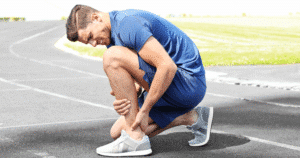
Why Running Matters
Running is one of the most popular physical activities worldwide, with millions participating in annual marathons and ultramarathons. While it offers numerous health benefits—including a lower risk of cardiovascular disease and improved mental well-being—running also comes with a high risk of injuries, particularly in the foot and ankle.
Standard Foot and Ankle Injuries in Runners
Despite being a non-contact sport, distance running places repetitive stress on the lower limbs, often leading to overuse injuries. Some of the most common running-related injuries include:
Stress fractures: Tiny cracks in bones caused by repeated impact. Learn more about stress fractures
Tendinitis: Inflammation of tendons, commonly affecting the Achilles tendon. Explore tendon injury care
Plantar fasciitis: Painful tissue inflammation along the bottom of the foot. Read about plantar fasciitis treatment
Ankle sprains: Ligament injuries from sudden twisting movements. Treating sprains and strains
Metatarsalgia: Pain in the ball of the foot due to excessive pressure.
Understanding Biomechanics and Running Form
The way your foot strikes the ground can significantly impact injury risk. There are three primary foot strike patterns:
Heel Strike: The heel makes contact first, commonly seen in traditional running styles.
Midfoot Strike: The middle of the foot lands first, distributing impact forces more evenly.
Forefoot Strike: The ball of the foot lands first, often reducing impact on the heel but increasing strain on the calf muscles. Studies have shown that runners who habitually heel strike may be at a higher risk for specific injuries due to greater impact forces. However, transitioning to a new foot strike pattern should be done gradually to avoid overstressing different muscles and tendons. Get help from a sports medicine specialist.
The Role of Footwear and Orthotics
Selecting the right running shoes is crucial for injury prevention. While some runners prefer cushioned shoes for added comfort, others opt for minimalist footwear to encourage a natural running form. There is no one-size-fits-all solution, but runners should prioritize:
Proper fit and comfort: Shoes should accommodate foot shape and size.
Arch support: Essential for those with flat feet or high arches.
Shock absorption: Helps reduce impact forces, particularly for heel strikers.
Orthotics may also affect foot stability and alignment. While some runners benefit from custom orthotics to correct biomechanical imbalances, research suggests that comfort is the most critical factor in injury prevention.
Strengthening the Foot and Ankle
To reduce injury risk and enhance performance, runners should strengthen the foot’s intrinsic muscles. Effective exercises include:
Short Foot Exercise: Contracting foot muscles to enhance the arch.
Toe Yoga: Independent toe movements to improve control and stability.
Resistance Band Work: Strengthening dorsiflexion, inversion, and eversion movements.
Calf Raises: Strengthening the Achilles tendon and lower leg muscles. If you’re dealing with weakness or ongoing issues, consider physical therapy services at OSMC.
Preventing and Treating Running Injuries
Runners can minimize injury risk by following these key strategies:
Gradual Training Increases: Avoid sudden mileage spikes to prevent overuse injuries.
Cross-Training: Incorporating swimming, cycling, or strength training to reduce repetitive stress.
Adequate Rest and Recovery: Rest days are crucial for muscle and joint healing.
Addressing Deficiencies: Ensuring adequate vitamin D and calcium intake to maintain bone health.
Physical Therapy: Seek professional care for persistent pain or biomechanical issues.
Conclusion
Long-distance running is an excellent way to stay fit but requires proper preparation, awareness, and injury prevention techniques. Understanding the biomechanics of running, choosing the appropriate footwear, strengthening foot and ankle muscles, and listening to your body can help keep you running strong and injury-free. If you experience persistent pain, consult an orthopedic specialist at OSMC to ensure you get the proper treatment and continue enjoying the sport safely.


